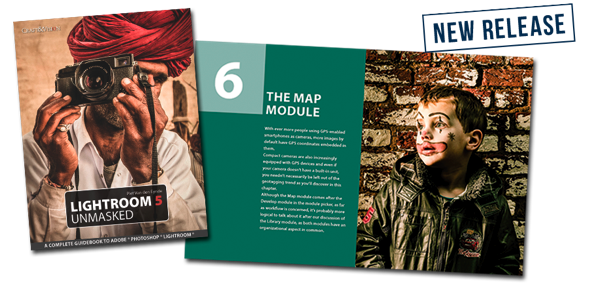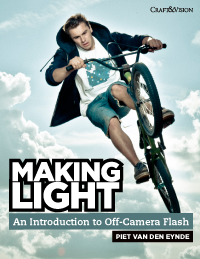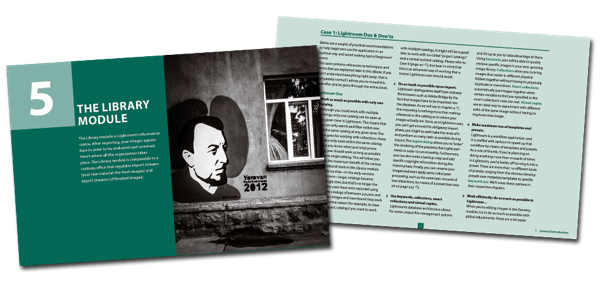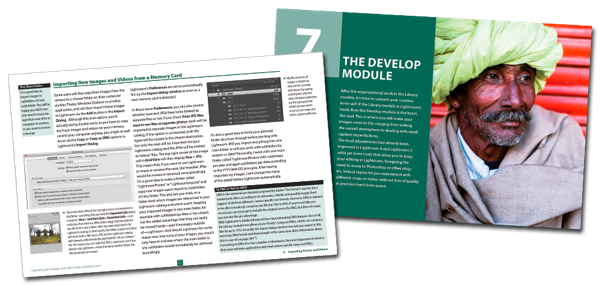I had the pleasure of chatting over email with fellow Craft and Vision author Piet Van den Eynde today, about his photography and his new eBook “Lightroom 5 Unmasked“.
Hi Piet,
We’ve known each other for a long time over our Lightroom love and connections, but obviously use of Lightroom implies that we’re both photographers. What got you into photography?
Well, years ago, I had a job in the finance sector which is as dull as it sounds. I needed something creative as an antidote and since I was too lazy and too impatient to draw and I can’t recognise a ‘mi’ from a ‘re’ and I sound like a strangled cat when I sing, I chose photography.
You’ve written on a wide variety of topics for Craft and Vision, but the photographs in the book tend to harken back to your travel photography. Tell us about your Portraits of Asia trip.
Well I got fired from that above-mentioned job with the start of the financial crisis five years ago and as my girlfriend and me always had been willing to go on a long trip, that was the perfect occasion so instead of whining about the lost job I was excited about the opportunities. We left for a one-year bicycle trip in which we covered parts of Turkey, Iran, India and Indonesia. I took along a small portable printer to thank the people that allowed me to photograph them by giving them a print and it’s been something that I have continued to do every since.

You’ve done more travelling since then, where was your favourite? Where do you really want to go back to?
From those four countries, who were all wonderful, Iran and India have struck me the most. Iran because of the completely false idea that we, as Westerners, have of its inhabitants who are just about the friendliest people I have ever encountered. India because it’s such a maddening, deafening but at the same time crazy, charming and vibrant country. I’ve been back to both countries and I’m looking forward to going back again.
I came to Craft and Vision from conversations with David duChemin on Twitter, how did you get involved with them? They’re great people.
Well, I did too, in a way: in 2010, I took a Lumen Dei workshop with Matt Brandon and David duChemin in Ladakh. At that time – and still very much so – I was heavily into digital black and white. David saw some of my images and asked if I would write a book for Craft & Vision(The Power of Black and White in Adobe Lightroom). And the rest, as they say, is history. It’s such a pleasure working with them. In my time as a writer, I’ve seen two ‘classical’ print publishers for which I wrote go bankrupt whereas Craft & Vision just continues to grow and bring out one interesting e-book after another.
 They do have a great range of subjects and authors. Before I talk about your new book, I want to ask about the cover photo. It’s a fantastic advert for the Fuji X system. What’s your connection there? I’ve been using the OM-D myself and am intrigued by the Fuji’s.
They do have a great range of subjects and authors. Before I talk about your new book, I want to ask about the cover photo. It’s a fantastic advert for the Fuji X system. What’s your connection there? I’ve been using the OM-D myself and am intrigued by the Fuji’s.
Yes it’s one of my favourite images from last year’s Rajasthan photo workshop, which was led by Matt Brandon and on which I was a Lightroom guest instructor. I have been on the lookout for a smaller, lighter yet high quality camera system and when the Fuji X series came out, I was sold immediately. The fact that the cameras just look gorgeous is an added bonus. I strongly believe that the form factor of the camera helps me create images that I wouldn’t create with a DSLR and I think the cover image is the proof of that.
I understand. I’ve travelled a lot with the OM-D EM-5 setup myself. What is your travel kit like these days?
Nowadays, my travel kit consists of a Fuji X-Pro 1, an X-E1 and an X100s (although I will exchange both for two X-E2’s), a slew of Fuji film lenses of which the 14 and 35mm currently are my favourites. Yet, I’m eagerly awaiting the advent of the 10 to 24 mm and the 56 mm 1.2 which I will then probably just glue to my cameras! On top of that I carry a printer that I will probably in the near future exchange for a Fujifilm Instax camera. I also carry filters by a British company called Formatt Hitech (www.formatt-hitech.com) and my inseparable flash and Lastolite trifold umbrella.
 I have the Fuji Instax and love it. Speaking of flash, 2 of your books are on lighting with strobes (Making Light 1&2), has much changed with your lighting since writing them?
I have the Fuji Instax and love it. Speaking of flash, 2 of your books are on lighting with strobes (Making Light 1&2), has much changed with your lighting since writing them?
I would say that in general, I try to be but more sophisticated in my lighting, either trying to make it look really natural or really lit, but in a good, professional way. I’ve started to use rim light a lot more and while traveling, I use the sun as a rim light which makes for really nice three dimensional images. I’ve also experimented a lot with high speed sync. Working more and more with the Fuji system and its no-thrills flash capabilities has made me happy that I never relied too much on TTL but that I know how to operate a flash manually.
I’ve also started to use an Elinchrom Ranger Quadra in my workflow. There’s a lot happening gear-wise. Like lately, Phottix announced the Mitros+ which is a flash with a built-in radio receiver. That’s great because you don’t longer have to fiddle with two pieces of gear or two sets of batteries.
I’ve 3 of the older Quadras and use them a fair bit. The Mitros+ sounds interesting. Your new book Lightroom 5 Unmasked is an update of the earlier version (of which I said “I’m truly wishing this is a book I wrote!“. I know from my book update, the new features meant a lot of new screen captures for older features. How was that for you?
It was a pain! Every screenshot that had a histogram in it had to be redone because of the new Smart Previews indicator and every screenshot that had the local adjustments toolbox in it also had to be redone because of the radial filter. I always joke that writing a software book is not difficult, it’s making the screenshots that is!
I feel your pain on that! Tell us about your writing process? Is it organic (as in sitting down when you can) or are you more structured with it? Of course deadlines can dictate how much you’re doing!
If by ‘organic’ you mean ‘chaotic’ then yes, it’s highly organic! Seriously, though: I start with the broad outlines and then refine. It’s like a tree: you start with the stem, then the branches, then the twigs and then the leaves… The more you’ve got the overall structure worked out, the easier it is to fill in the small details (the leaves).
It sounds a lot like my process. The first version, Lightroom 4 Unmasked was a really comprehensive book, and I really loved the case studies. The new book is much longer. What’s been the biggest changes in your workflow between the 2 books?
I’d definitely say Smart Previews. They’re worth the upgrade price by themselves and I’ve dedicated a very long case to their possible use. I have two computers, one desktop in my office (on the second floor of our house) and one laptop. Up until recently, my catalog was on the desktop and if I needed to work a little on my laptop, I exported a part of my main catalog as a catalog (a process which I’ve always found cumbersome). But we recently had a baby, and in between changing diapers and helping with feeding bottles, the iMac on my desk is gathering dust. So I put my Catalog, Previews and Smart Previews on a fast external drive (a Lacie SSD Thunderbolt) and now I work from that, connecting it to the computer I want to work with (which is mostly my laptop, nowadays). I connect it back to my desktop when I want to print or export high res files, because my raw files are stored on a Drobo that’s connected to the desktop computer (and that, because it weighs 10 pounds, I don’t feel like lugging along).
 What was the inspiration for splitting off between the explanation of Lightroom tools, and the case studies?
What was the inspiration for splitting off between the explanation of Lightroom tools, and the case studies?
Well, the bulk of what you need to know is in the main text. The case studies just go into more detail. Also, they stand by themselves, so if you don’t feel like reading a whole chapter, you can still read a Case study and learn a lot. Frankly, I think the case studies by themselves are worth the $20!
I wouldn’t disagree, the material is really strong. In one of the case studies you cover some iPad workflow, and I see both Photosmith and Minimal Folio being mentioned. I’ve been a Minimal Folio user for many years, and I love the Dropbox integration via Publish. Does the iPad see much use in your travel workflow?
No, I mention Photosmith because I want to be complete, but I don’t use it myself. Up to now, I found that iPad integration at the start of the workflow is very cumbersome and creates more problems than it solves. I’d rather take a Macbook Air or something with me. But I do like the iPad as a publishing device, and that’s where Minimal Folio comes in. That’s also one of the things that sets my book apart from many other Lightroom books: that I mention third party solutions and plug-ins that can further enhance your Lightroom experience. Now, with the demo that Lightroom PM Tom Hogarty did of a Lightroom-esque App on the iPad, my opinion about using an iPad might change!
 I got pretty excited about that particular podcast. It looked really good. Will you get a break now, or is there another book on the horizon?
I got pretty excited about that particular podcast. It looked really good. Will you get a break now, or is there another book on the horizon?
There’s actually another C&V eBook coming out soon, but that’s already written. I’m now working on a series of Dutch Lightroom training videos for www.photofactsacademy.nl and then I hope that the Lightroom team don’t release version 6 any time soon, because I really could use a break with the wife and kid! And a holiday. To India. Or Iran! Or maybe just the Belgian coast!
Never a dull moment! Thanks for taking time to answers questions and good luck with the new book.
Lightroom 5 Unmasked is out now. Use the promotional discount code UNMASKED3 when you check out and pay only $17 OR use the code UNMASKED20 to get 20% off when you buy 5+ Craft & Vision products. Codes expire at 11:59 PM (PST) November 4, 2013.
(Book links are affiliate links)











